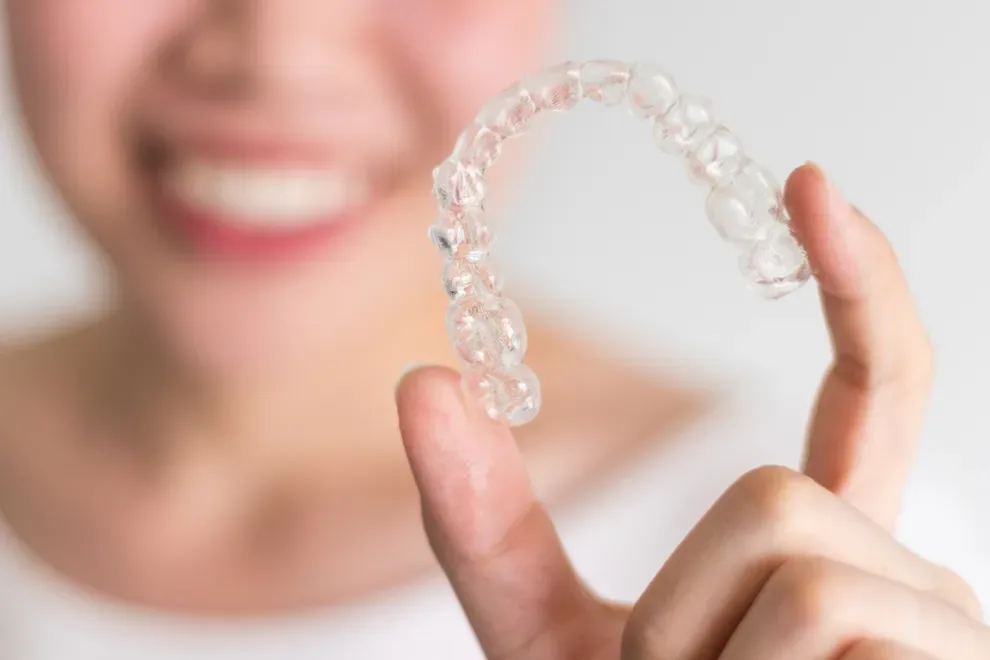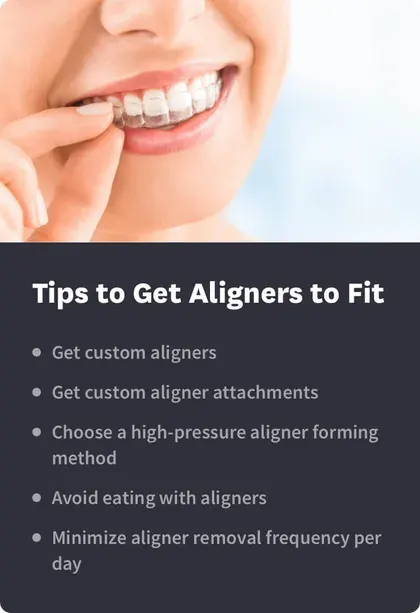Aligners: How Should They Fit? Tips to Getting the Right Fit

Table of Contents
- Causes of Fit Issues
- Tips for Fit
- Accessories to Help
- Frequently Asked Questions
- References
Once you’ve inserted your first pair of aligners, you’ll experience decreasing pressure levels on your teeth until the intended treatment is achieved.
On Day One, aligners snap into position, fitting snugly around your teeth. They’ll feel looser in about three to four days as your teeth adjust and shift into place.
If treatment goes as planned, your dentist or orthodontist will achieve the desired amount of tooth movement by the end of the first or second week.
At this point, your aligners should feel loose, enough that you will feel you’re ready for replacements. This experience should recur each time you replace these appliances until your teeth attain a perfect alignment.
Causes of Fitting Issues

Each person has a unique experience with clear aligner therapy (CAT) systems. If your aligners don’t fit right, the cause can be anything, from the technology and materials used to treatment compliance and appliance care.
Potential triggers of CAT fitting or retention problems include:
Frequent removal
Chewing on one side of the mouth
Aligner damage
Aligner material
Attachment material
Besides aligners, some patients need special attachments that bond to their teeth. Aligners fit tightly around these attachments, preventing retention issues.
The bond between these reinforcements and teeth weakens faster with frequent removal and insertion of aligners per day. In a few days, the appliance may get loose way before it’s due for replacement.
Because of an uneven application of force when eating, bonded attachments on one side of the aligners can wear out faster than on the opposite side. This can cause a tighter fit on one side, and a poor one on the other.
You may experience this if you regularly eat with your aligners on and if you tend to eat on one side of your mouth all the time. Most of us don’t know which side of the mouth we chew on. If you are someone who wears aligners, you’ll want to pay attention when you eat if you eat with your aligners on.
Aligners may degrade faster on exposure to high temperatures. Significant damage can occur when you regularly eat hot foods with the appliances on.
Thicker aligner material causes the system to adhere more closely to the tooth surface. Stiffer materials make for a tighter fit, too.
Composite resin that bonds to the tooth surface is the most critical part of an aligner attachment. Bonding failure can occur when this material is weak due to a manufacturing defect.
It may not adhere strongly enough to the tooth surface, compromising the stability of your aligners.

Tips to Get Aligners to Fit
Here are some of the tips to ensure your aligners fit the way they’re supposed to:
Get a custom fit
Get aligner attachments
Choose a proper aligner forming technique
Biting down on aligner chewies
Eat the right foods (or avoid the wrong food)
To minimize the risk of experiencing fitting issues down the line, get custom-made aligners at the outset.
Advanced CAT technology, especially digital imaging and computer-aided 3D modeling, plays a vital custom-staging role today. It enables orthodontists to design and develop highly personalized, accurate teeth alignment plans.
Your dentist can use CAT software to work out the precise amount of force for the micro-movements each tooth makes. They can also more accurately predict the position of each tooth at every stage of treatment, including a year down the line.
Precision matters. Even a minuscule shift of a tooth impacts how the aligner on it fits.
Aligner therapy can work without these additional dental appliances. During the customized staging phase of treatment, your doctor will decide whether you need them for a proper fit.
However, some patients experience fitting problems after beginning CAT without the attachments. If your aligners become too loose or fall out prematurely, you should contact your dentist right away.
You might need custom-made attachments to improve the fit.
These special reinforcements can help to improve the comfort of your aligners. Other applications include controlling the amount of force applied to shift your teeth and expanding the range of tooth movement.
Several CAT systems are on the market. How each system works impacts its tooth-retention ability to some extent. You can discuss these options with your doctor for help selecting the right one for your needs.
Generally, high-pressure methods tend to form better fitting aligner surfaces.
CAT system developers recommend removing aligners before meals. You should avoid eating hot foods when wearing the appliances. This habit can also help prevent a host of dental health and cosmetic issues, including stained aligners.
Accessories to Help your Aligners Fit
Seaters are orthodontic setters, usually made of a soft plastic, that help to close any gap between your teeth and aligners. Chewing on these seaters may help “snap” your aligners into place. This is especially helpful right after switching to a new aligner tray, when the aligners may feel a bit tight or out of position.
Aligner chewies can push your aligners a little closer to the tooth surface. A better fit improves not only comfort, but also the effectiveness of your aligner therapy.
Check with your dentist or aligner provider before including chewies or seaters into your treatment.
Byte includes its HyperByte high-frequency massage device in every aligner kit. Research has indicated that devices like these can shorten treatment time for clear aligners.
HyperByte transmits soft micro-pulses through the roots of your teeth to the surrounding bone, stimulating movement. This may allow for faster rates of corrective tooth shifting, without causing discomfort or pain.
Aligner Fit Frequently Asked Questions
A new set of aligners won’t fit perfectly. They’ll be a bit tight on day one before starting to loosen up in a few days as your teeth shift in a series of small movements. This experience occurs when your customized treatment plan is working, meaning that the aligners have your teeth in the desired position.
Your aligners should feel loose only after your teeth have moved to the proper position at each phase of treatment. They should be a little tight the first time you wear them.
Call your dentist or the aligner company if the appliances become too loose to the point of falling out or causing serious discomfort.
